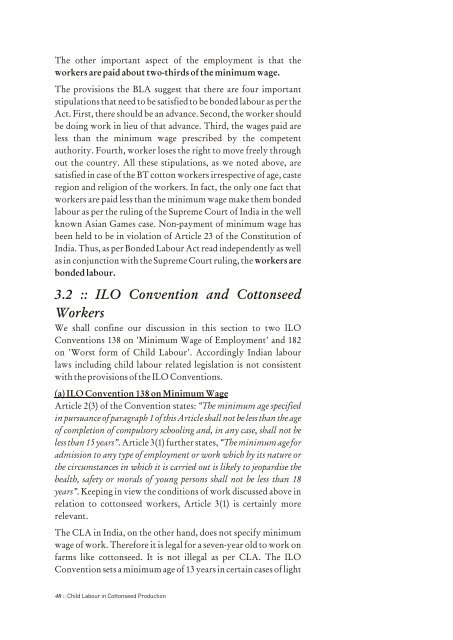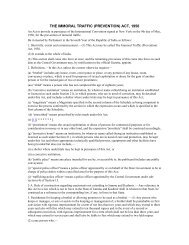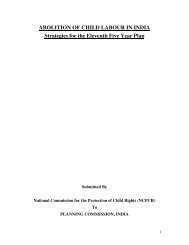Child Labour in Cottonseed Production by Ashok Khandelwal
Child Labour in Cottonseed Production by Ashok Khandelwal
Child Labour in Cottonseed Production by Ashok Khandelwal
Create successful ePaper yourself
Turn your PDF publications into a flip-book with our unique Google optimized e-Paper software.
The other important aspect of the employment is that the<br />
workers are paid about two-thirds of the m<strong>in</strong>imum wage.<br />
The provisions the BLA suggest that there are four important<br />
stipulations that need to be satisfied to be bonded labour as per the<br />
Act. First, there should be an advance. Second, the worker should<br />
be do<strong>in</strong>g work <strong>in</strong> lieu of that advance. Third, the wages paid are<br />
less than the m<strong>in</strong>imum wage prescribed <strong>by</strong> the competent<br />
authority. Fourth, worker loses the right to move freely through<br />
out the country. All these stipulations, as we noted above, are<br />
satisfied <strong>in</strong> case of the BT cotton workers irrespective of age, caste<br />
region and religion of the workers. In fact, the only one fact that<br />
workers are paid less than the m<strong>in</strong>imum wage make them bonded<br />
labour as per the rul<strong>in</strong>g of the Supreme Court of India <strong>in</strong> the well<br />
known Asian Games case. Non-payment of m<strong>in</strong>imum wage has<br />
been held to be <strong>in</strong> violation of Article 23 of the Constitution of<br />
India. Thus, as per Bonded <strong>Labour</strong> Act read <strong>in</strong>dependently as well<br />
as <strong>in</strong> conjunction with the Supreme Court rul<strong>in</strong>g, the workers are<br />
bonded labour.<br />
3.2 :: ILO Convention and <strong>Cottonseed</strong><br />
Workers<br />
We shall conf<strong>in</strong>e our discussion <strong>in</strong> this section to two ILO<br />
Conventions 138 on 'M<strong>in</strong>imum Wage of Employment' and 182<br />
on 'Worst form of <strong>Child</strong> <strong>Labour</strong>'. Accord<strong>in</strong>gly Indian labour<br />
laws <strong>in</strong>clud<strong>in</strong>g child labour related legislation is not consistent<br />
with the provisions of the ILO Conventions.<br />
(a) ILO Convention 138 on M<strong>in</strong>imum Wage<br />
Article 2(3) of the Convention states: “The m<strong>in</strong>imum age specified<br />
<strong>in</strong> pursuance of paragraph 1 of this Article shall not be less than the age<br />
of completion of compulsory school<strong>in</strong>g and, <strong>in</strong> any case, shall not be<br />
less than 15 years”. Article 3(1) further states, “The m<strong>in</strong>imum age for<br />
admission to any type of employment or work which <strong>by</strong> its nature or<br />
the circumstances <strong>in</strong> which it is carried out is likely to jeopardise the<br />
health, safety or morals of young persons shall not be less than 18<br />
years”. Keep<strong>in</strong>g <strong>in</strong> view the conditions of work discussed above <strong>in</strong><br />
relation to cottonseed workers, Article 3(1) is certa<strong>in</strong>ly more<br />
relevant.<br />
The CLA <strong>in</strong> India, on the other hand, does not specify m<strong>in</strong>imum<br />
wage of work. Therefore it is legal for a seven-year old to work on<br />
farms like cottonseed. It is not illegal as per CLA. The ILO<br />
Convention sets a m<strong>in</strong>imum age of 13 years <strong>in</strong> certa<strong>in</strong> cases of light<br />
48 :: <strong>Child</strong> <strong>Labour</strong> <strong>in</strong> <strong>Cottonseed</strong> <strong>Production</strong>





